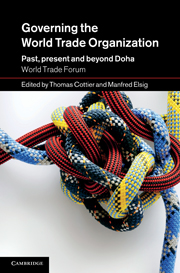Book contents
- Frontmatter
- Contents
- List of figures
- List of tables
- Notes on Contributors
- Preface
- List of abbreviations
- 1 Introduction
- PART I Setting the stage
- PART II Boundaries
- PART III Emerging and established powers
- PART IV Weaker actors
- PART V The consensus principle
- 10 The WTO as a ‘living instrument’: the contribution of consensus decision-making and informality to institutional norms and practices
- 11 Crisis situations and consensus seeking: adaptive decision-making in the FAO and applying its lessons to the reform of the WTO
- PART VI Quo vadis?
- Index
- References
10 - The WTO as a ‘living instrument’: the contribution of consensus decision-making and informality to institutional norms and practices
Published online by Cambridge University Press: 07 September 2011
- Frontmatter
- Contents
- List of figures
- List of tables
- Notes on Contributors
- Preface
- List of abbreviations
- 1 Introduction
- PART I Setting the stage
- PART II Boundaries
- PART III Emerging and established powers
- PART IV Weaker actors
- PART V The consensus principle
- 10 The WTO as a ‘living instrument’: the contribution of consensus decision-making and informality to institutional norms and practices
- 11 Crisis situations and consensus seeking: adaptive decision-making in the FAO and applying its lessons to the reform of the WTO
- PART VI Quo vadis?
- Index
- References
Summary
Introduction
The Marrakesh Agreement Establishing the WTO (the WTO Agreement) and the annexed multilateral trade agreements, while firmly rooted in treaty law and representative of a set of binding obligations between the members, are nevertheless evolutionary in character. By this I mean that they are capable of adaptation and further development. They therefore constitute a ‘living instrument’. Characteristic of this are the various practices and customs that exist in the WTO, which are generated, or supplemented, by the practice of members in the institutional sphere. Normatively speaking, they form part of the ‘established practice of the organization’ and are considered as ‘rules of the organization’ in the sense of Article 2:1(j) VCLTIO. The two ‘aides-de-camp’ in this development are consensus decision-making and informality, both of which act as agents of incremental change and contribute to keeping the WTO alive.
This chapter begins with a brief explanation of what is meant by describing the WTO as a living instrument, where institutional practices and institutional norms contribute to the organisation's further development. It then focuses on the role of consensus decision-making and the way in which informality has operated in the process of collective decision-making under the General Agreement on Tariffs and Trade/World Trade Organization (GATT/WTO) and its effects on that process. First, during the GATT era, informal processes gradually gave way to more formal ones.
- Type
- Chapter
- Information
- Governing the World Trade OrganizationPast, Present and Beyond Doha, pp. 217 - 240Publisher: Cambridge University PressPrint publication year: 2011



